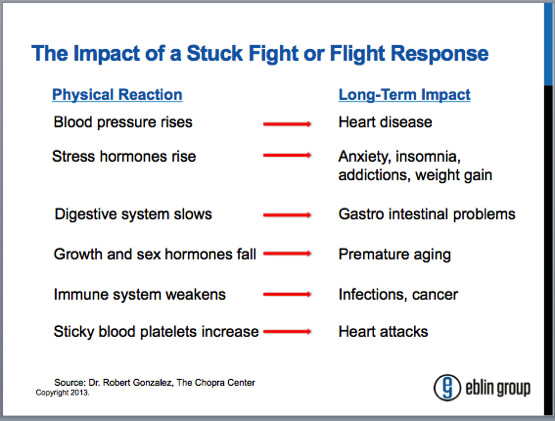Chill Out. Your Life Depends On It
Take a chill pill and be a bit more healthy with these tips.
Along with my normal routine of coaching, speaking and writing, my big project this summer has been taking a 200 hour course to become a certified yoga instructor. While I don’t plan to chuck everything else and start teaching yoga full time, it’s been a really great experience – enlightening, challenging and humbling all at the same time. And, I’m happy to report, it wraps up next week. It’s been fun, but it will be nice to have my weekends back.
I spent a good part of this past weekend working on the take home version of the final exam. (The in-class exam is next week – wish me luck!). One of the questions on the take home was right in the wheel house of what I’ve been writing about in the Mindful Mondays feature so I thought I’d share it with you.
It’s about how chilling out can save your life. Here’s the story.
Your sympathetic nervous system is responsible for keeping your body vigilant and ready to move into action. From an evolutionary standpoint, it’s where the fight or flight response resides. When a part of the brain called the amygdala senses a threat, it releases neurochemicals and hormones that activate the parts of the body needed to respond to a threat and reduces the activity in parts of the body such as the digestive tract and the immune system that are less important to dealing with an immediate physical threat. All of that was really useful when the daily threat to living could include the sabre tooth tiger around the next rock. It’s less helpful when the fight or flight response is activated by the daily pressures of modern life.
The big problem is when the stressors keep coming so fast and furious that your fight or flight response stays switched on more or less all the time. The long term impact of that can literally be life threatening. This chart, which summarizes a talk I heard recently by Dr. Robert Gonzalez of the Chopra Center, shows the devastating impact of a fight or flight response that’s stuck in the on position:

The good news is that we also come equipped with a parasympathetic nervous system (PNS). Activating the PNS is the key to chilling out and getting out of chronic fight or flight mode. The parasympathetic response can reduce the rise in blood pressure that results from stress and also brings the digestive, reproductive and immune systems back into a state of balance.
What can you do to bring the PNS online? Here are three simple things you can do today. Try one of them the next time you notice that you’re grinding your gears:
Breathe : As I wrote in last week’s Mindful Mondays post on Stop, Look and Listen , a few minutes of deep intentional breathing can push the reset button in a very positive way. Focus more on the exhales than the inhales and notice what the impact is on your thermostat.
Stretch : Your body ends up holding onto a lot of the tension that the fight or flight response creates. (Your shoulders, jaw and gut are obvious places to look.) Five minutes or less of some good stretches can help you get the kinks out and turn on the PNS at the same time. Here’s a short slide show from the Mayo Clinic with some stretches you can do right now.
Walk : As in walk away from your desk. When you notice that whatever you’re working on is stressing you out, that’s a good sign to take a literal or figurative walk. Go do something else for 15 minutes that’s completely unrelated to what you’ve been grinding on. If you throw in a little deep breathing at the same time, chance are that your PNS will do its job and help you chill out a bit.
Learning how to chill out can not only save your life, it can help you be a better and more mindful leader. What do you do to chill out when your fight or flight response is on overdrive?
Image via Nito/Shutterstock.com




